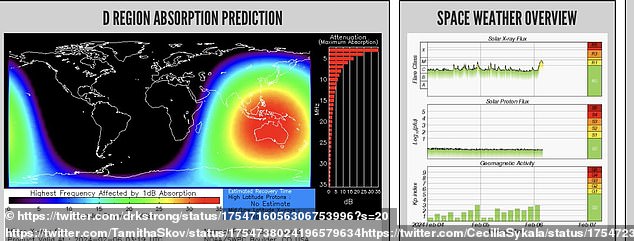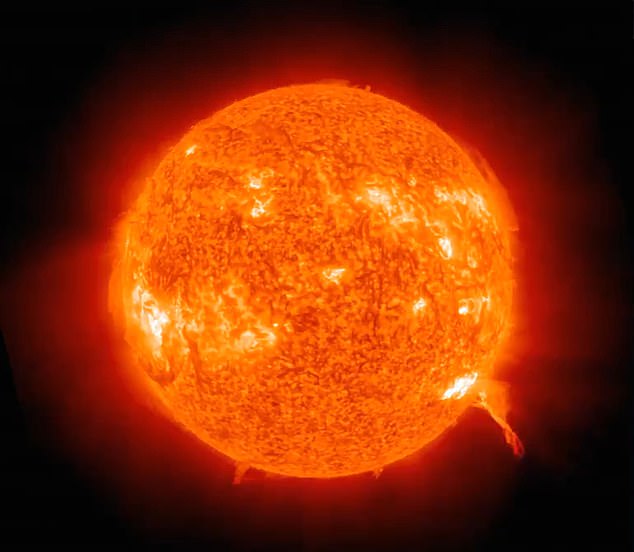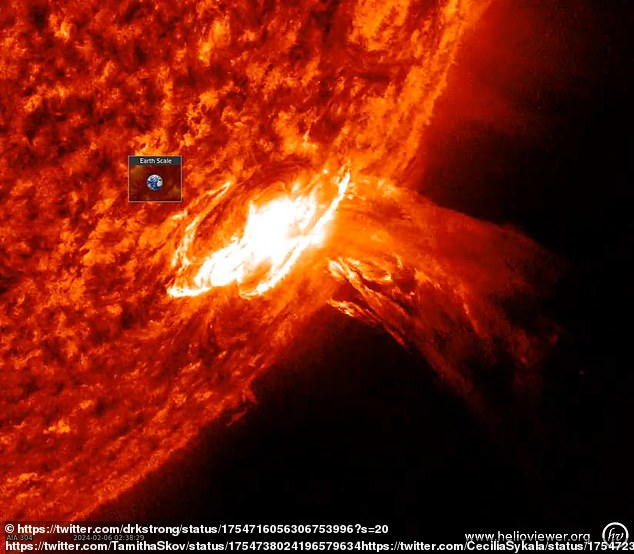Massive explosion on the sun causes power outages near Australia and Asia – as NOAA shows a 45% chance of radio interference in the coming days
- On Monday, a gigantic solar flare erupted from the sun and reached Earth today
- Reports indicated that power outages occurred near Australia and South Asia
- READ MORE: The sun erupted with the most powerful solar flare in six years
An explosion on the Sun released a huge plume of energetic particles that drifted through space at 900,000 miles per hour, causing power outages in Australia and South Asia.
Reports surfaced Tuesday morning noting that ham radio operators and sailors had been disrupted around the two targets.
The long-lasting burst was released at 8:30 PM ET on Monday, and the solar storm reached our planet shortly after 10 AM ET today.
NOAA’s Space Weather Prediction Center shows there is a 45 percent chance of more communications outages in the coming days.
An explosion on the Sun released a huge plume of energetic particles that drifted through space at 900,000 miles per hour, causing power outages in Australia and South Asia
Physicists noted that the explosion was a class M eruption, which can cause small (R1) to moderate (R2) radio outages on the daylight side of Earth.
The warning is largely intended for frequencies used by aviation communications, government time stations, weather stations, amateur radio and citizen band services, among others.
Physicist Dr. Tamitha Skov told DailyMail.com in January: ‘Those (typically) affected are people who rely on GPS/GNSS services, especially at high latitudes, but also precision farmers and anyone who uses UAVs for reconnaissance, search and rescue or aerial photography .
Strong M-class eruptions, like what was observed on Monday, can cause a coronal mass ejection (CEM), which are large clouds of plasma and magnetic field erupting from the Sun.
The emissions contain billions of tons of corona material from the sun’s surface.
CEMs can create a geomagnetic storm that temporarily disrupts Earth’s magnetosphere and satellites in orbit through a shock wave from the solar wind.

Reports emerged Tuesday morning that ham radio operators and sailors had been disrupted around the two targets

Keith Strong, a solar physicist, shared on
Keith Strong, a solar physicist, shared on
EarthSky forecasts showed that there is a 99 percent chance of C flares, a 60 percent chance of M flares and a 25 percent chance of X flares in the next 24 hours.
C-class outbursts are small and have little noticeable impact on Earth, while they are large events that can cause radio disruptions and long-lasting radiation storms in the upper atmosphere around the world.
The unstable sunspot was identified as AR3575, which fired the M flare towards Earth.
However, the region AR3576 is also moving towards our planet and is so large that NASA’s Mars rover spotted it last week.

NOAA’s Space Weather Prediction Center shows there is a 45 percent chance of more communications outages in the coming days
The sun’s wrath caused power outages on Earth less than a month ago.
Data showed that the incident occurred around 4:20 PM ET in the waters off the western US and South America, but lasted only a few seconds.
The poles were also hit by the powerful flow of high-energy particles, with the disturbance lasting about seven hours.
The radio waves (called ‘radio bursts’) affect our reception of satellite signals such as GPS and even HF radio communications,” Skov told DailyMail.com when the outage occurred on January 24.
‘It’s like the sun is literally screaming at us during a solar flare.
‘This ‘scream’ is much louder than our satellites can ‘beep’ and therefore temporarily drowns out the satellite signals.
“That said, the sun doesn’t always scream at the exact frequencies that affect GPS signals.”
